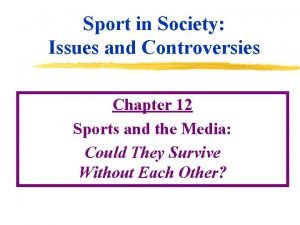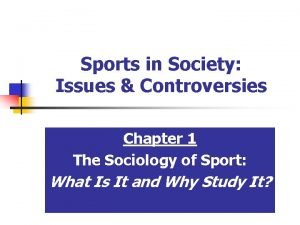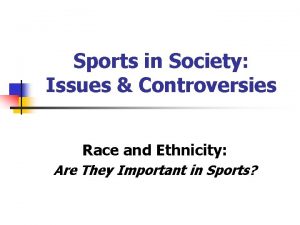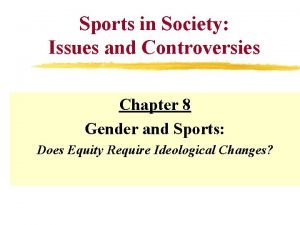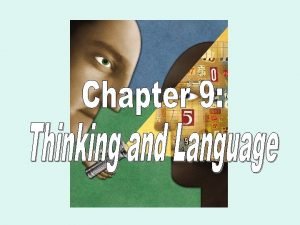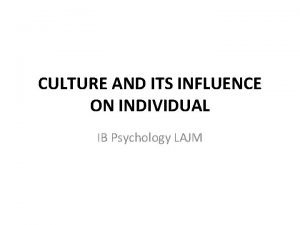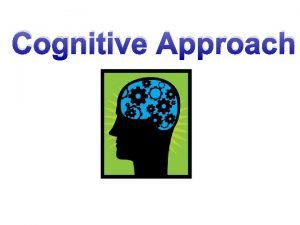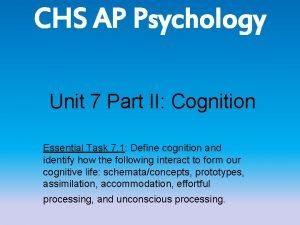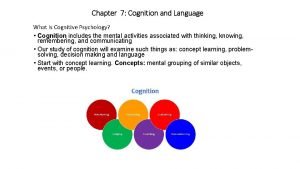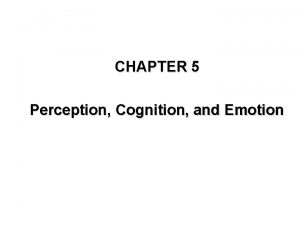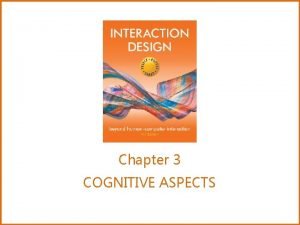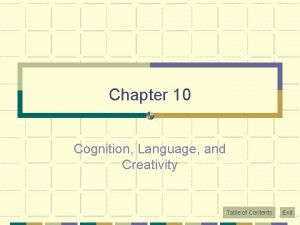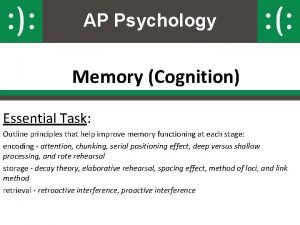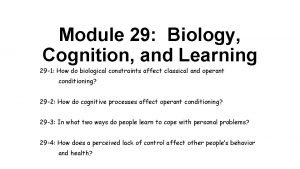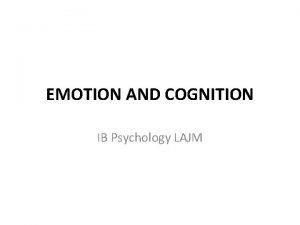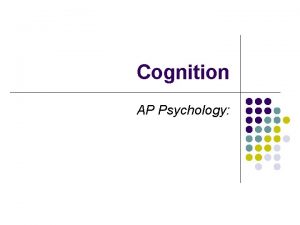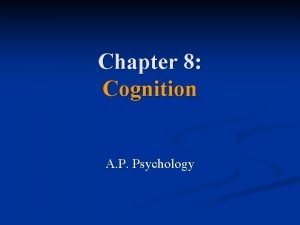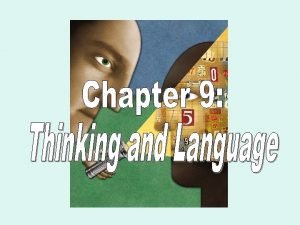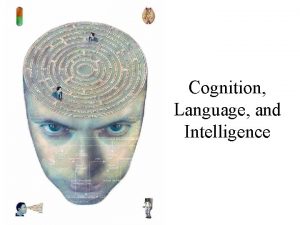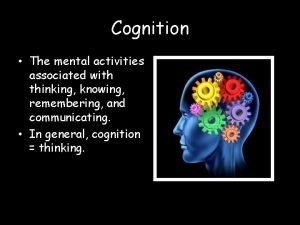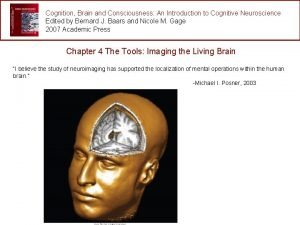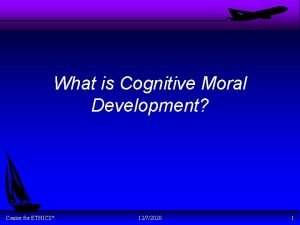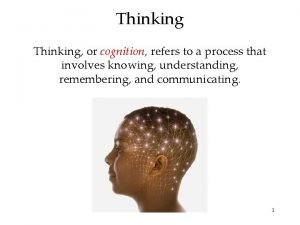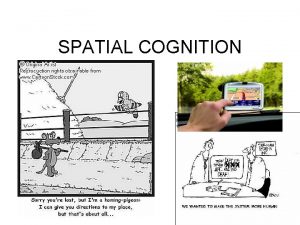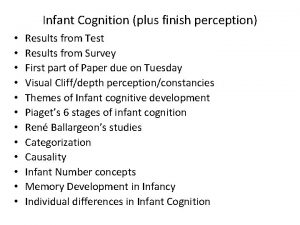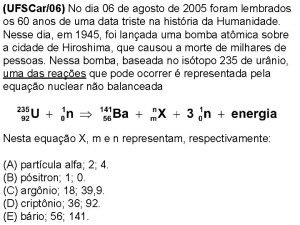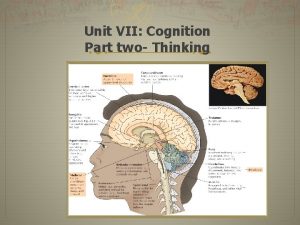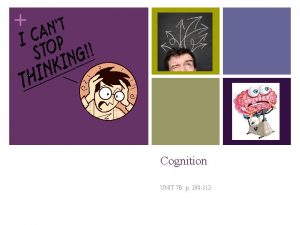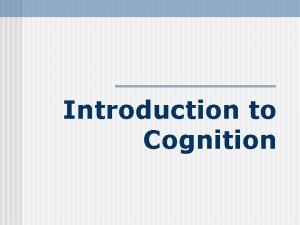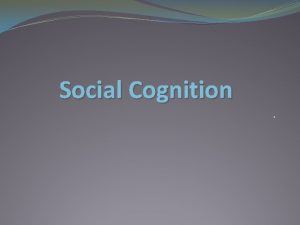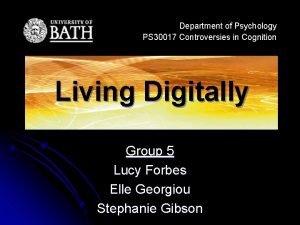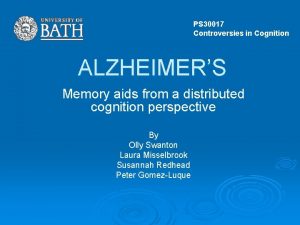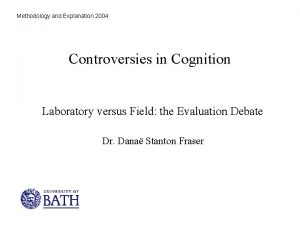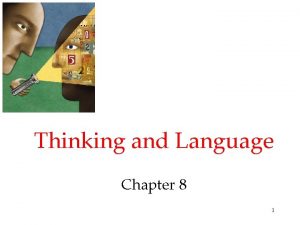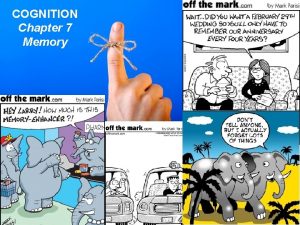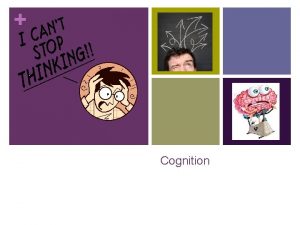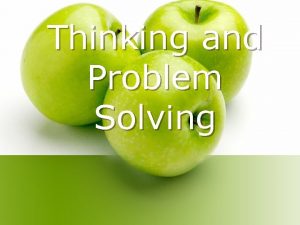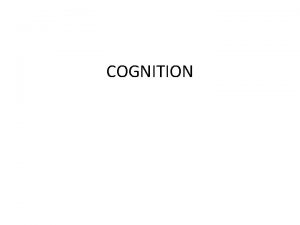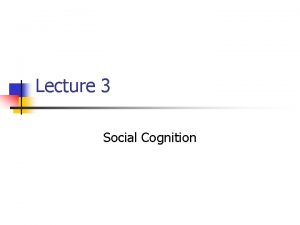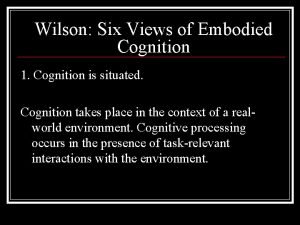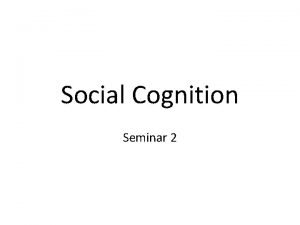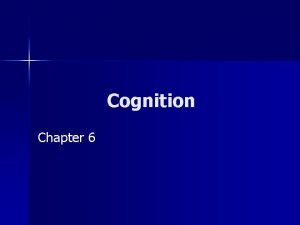Controversies 2005 Controversies in Cognition Introduction to Unit
















































- Slides: 48

Controversies 2005 Controversies in Cognition Introduction to Unit and Lecture 1: Space. Can we simulate it effectively? Dr. Danaë Stanton Fraser

Controversies 2005 Goals of this Unit • Generate an understanding of current issues and controversies in psychology. • After completing the unit you should: · Be familiar with current debates and their implications for the development of theory and methodology · Be able to present a critical perspective on the issues · Be able to evaluate the relevant perspectives in the controversies

Controversies 2005 Unit structure 1 st part of course lectures ( Danaë Stanton Fraser and Tim Jones) Topics include : • Space. Can we simulate it effectively? • Spatial Cognition: learning what has been 'learnt' from cognitive maps. • Laboratory versus Field: the Evaluation Debate • Estimating time-to-collision: can we accurately estimate when we will reach an object or when a moving object will reach us? • Evaluating ‘in the wild’ - Aiding Mobility: are electronic and environmental devices sufficient for aiding mobility in the mobility impaired? 2 nd part of course presentations by student groups 15 minutes presentation, 5 minutes questions

Controversies 2005 References and slides • References will appear at the end of the lecture slides. For your presentations you will be expected to have read widely. Slides available online at: http: //staff. bath. ac. uk/pssds/Cin. C. html

Controversies 2005 Assessment 2 assessed course works: • Group Presentation (20%) NB. The same mark is presented to all group members. All group members should present. • Individual Report (80%)

Controversies 2005 Presentations • You will sign up to groups after the next lecture • There will be a choice of topics related to the course • Presentations will take place in the final four lectures

Controversies 2005 Report • Individually written • 2000 -2500 words • Using material from your presentation, and appropriate psychology literature, choose one theme from the course and discuss how the chosen technology (e. g. VR, mobile devices) affects the way we learn and highlight the controversies surrounding this approach. • Refer to other presentations where possible. • Deadline: 12 noon Friday 19 th May

Controversies 2005 Space. Can we simulate it effectively?

Controversies 2005 Spaces and Maps: Physical, Mental and Virtual • • • Space The Cognitive Map Simulations of Space How real do simulations need to be? Presence Research in Virtual Environments (VEs)

Controversies 2005 Theories of Space Kant claims that “space and time are the very form of the human mind” (Ellis, 1991, p. xiii). Indeed everyday navigation and technological advances aiding exploration (flying, driving) involve complex spatial skill.

Controversies 2005 Space • Physical space refers to the three dimensional, Euclidean world in which we live. • Psychological space refers to the space of our perceptual experience, “any space which is attributed to the mind. . . and which would not exist if minds did not exist” (O’Keefe and Nadel, 1978, p. 6 -7). • These two types of space overlap and interact with one another. • We can also distinguish between virtual space and physical space, as virtual environments do not exist in the physical world.

Controversies 2005 Humans and animals must adopt strategies to gauge their constantly altering position within the environment if they are to successfully negotiate “that great God-given maze which is our human world” (Tolman, 1948, p. 208).

Controversies 2005 The Cognitive Map Mc. Gee (1982) defined spatial orientation as “the comprehension of the arrangement of elements within a visual stimulus pattern, the aptitude for remaining unconfused by the changing orientations in which a configuration may be presented and the ability to determine spatial relations in which the body orientation of the observer is an essential part of the problem” (p. 4).

Controversies 2005 3 D • We see our world in three dimensions. Although the retina in the eye is a flat surface and therefore the images it receives are two dimensional, distance cues enable some two dimensional images to be perceived as distant in a three dimensional world. • Monocular depth cues include relative size, superposition/occlusion and relative height. Relative size refers to smaller objects being interpreted as further away than larger objects. Occlusion is the effect when one object obstructs another, causing the overlapping object to be perceived as being nearer. The relative height of similar objects can enable distance perception, for example, objects that are seen as higher in the image are perceived as more distant.

Controversies 2005 3 D The use of two eyes (binocular vision) has advantages for depth perception. Our two eyes enable us to see two slightly different images of an object and we use this disparity to calculate the object’s orientation in space. The term stereopsis is used to explain how the brain adds depth from this disparity between the different images from the two eyes.

Controversies 2005 3 D Another type of depth cue arises from autonomous movement in space which appears to be crucial to the development of an effective internal spatial representation. Gibson (1966) stated that as the observer moves through space, there is a flow of stimulation on the retinas, which leads to a better understanding of the three dimensionality of our world. “When the observer moves. . the optic array becomes alive with motion” (Haber and Hershenson, 1973, p. 332).

Controversies 2005 The form of the Cognitive Map Tolman (1948) describes a “map control room” in the brain which stimuli enter and are “worked over” and “elaborated” into “a tentative, cognitive-like map of the environment” (p. 192). This “cognitive map” contains routes, paths and environmental relationships which are stored and can be used when responding to the environment. Thus accuracy of response to one’s environment is intricately linked to the quality of the cognitive map formed.

Controversies 2005 The form of the Cognitive Map • O’Keefe and Nadel (1978) drew a distinction between the “Taxon” system (routes) and the “Locale” system (places) in the build up of spatial knowledge. The “Taxon” system involves using a series of S-R-S (stimulus -response-stimulus) instructions. Navigation involves moving from one landmark to the next by aligning oneself in relation to the landmarks. The “Locale” system is a highly flexible system, based on the development and use of internal maps. • O’Keefe and Nadel (1978) state that exploration is essential for the creation of internal spatial cognitive maps and in constantly up-dating them.

Controversies 2005 The form of the Cognitive Map • Animal behavioural studies • Most authors agree that humans carry spatial representations of their environment in their heads, yet there is constant debate concerning the type and content of these representations. • Siegel and White (1975) suggest a three tiered process in the development of spatial knowledge: the use of landmarks, then the adoption of route knowledge allowing fairly simple wayfinding, and finally internal representations of space, allowing more sophisticated methods of navigation.

Controversies 2005 Landmarks, routes and maps • Siegel and White suggest that landmarks may constitute “meaningful events” and the nervous system may be continually “taking pictures” of them. • Routes are built up by connecting a series of landmarks. This strategy is egocentric (dependent on the body’s location and direction of pointing in space) and is efficient as long as the links between successive turns are accurate. • A cognitive map applies to the mental images that individuals build up as they become more familiar with their surroundings. This type of representation is allocentric (not dependent on the body’s position in space or direction of regard) and thus is extremely flexible

Controversies 2005 Properties of cognitive map • Pick and Lockman (1981) describe three properties of spatial maps: reversibility, transitivity and enabling detours. • Lynch (1960) suggests that the cognitive map is a product of the number and type of landmarks and the number and type of past experiences one has had in a particular location.

Controversies 2005 Cognitive Map (contd. ) • Thorndyke and Hayes-Roth (1982) state three important points about spatial cognition. Firstly, people build up their spatial knowledge from a variety of different sources: navigation through the environment, a wide variety of different forms of maps, verbal descriptions and photographs. The knowledge gained from each of these sources is integrated to form spatial knowledge. Secondly, dependent on the knowledge they have, people use different methods when making spatial judgements. Thirdly, the accuracy of any spatial judgement is dependent not only on the accuracy of spatial knowledge but also on the computations performed on this knowledge.

Controversies 2005 Virtual Environment (VE) • Virtual environments (VEs) have as their core the simulation by computer of three dimensional space. • The first defining feature of VEs is that they can be explored in real time with similar freedom to real world exploration. • The second defining feature is that the user may interact with objects and events in the simulation.

Controversies 2005 Application of VEs • Research using VE’s has stemmed from: – Military – Space – Aviation • VEs are now used in a wide variety of settings, including: – – – Education Medicine Building design Applications for those with disabilities …

Controversies 2005 • Desktop use of VE

Controversies 2005

Controversies 2005

Controversies 2005 Training and Education • Why use 3 D environments for training – – – – Take on different perspectives Visualise 3 D concepts Interact in real time Explore dangerous situations in safety Independent rehearsal Present realistic or abstract scenarios Promote different learning styles and teaching methods possess a high degree of flexibility

Controversies 2005 Training and Education • Environments to train specific skills • Important elements – safety, autonomy, repeated action enabled, reduction of clutter/noise, control. .

Controversies 2005 Training and Education • Health and safety routines and VR for workplace – practising emergency procedures in a variety of systems – simulators – Some examples: Learning about radioactivity, Product development, Training for disposal

Controversies 2005 Training and Education • Social skills – E. g Autism – Independent rehearsal, taking others perspectives, safety, practicing behaviours – www. avirtualdayout. co. uk

Controversies 2005 Training and Education • Phobias – Agrophobia, arachnophobia fear of flying… www. equator. ac. uk

Controversies 2005 Training in VEs • Virtual environments are potential useful media for training spatial skills: • Interactions with VEs reproduce similar visual-spatial characteristics to interactions with the real world • Interactions with VEs can preserve the link between motor actions and their perceived effects (Regian, Shebilske and Monk, 1992). This may be primarily due to the three dimensionality of the display, which provides all of the transformations in the visual appearances of objects that would accompany real movements in space. In Gibson’s (1979) terms, the optical flow patterns that would be experienced in the course of real movements are maintained in the displayed environment.

Controversies 2005 Training in VEs (contd. ) • VEs enable assessment of the internal spatial representations within the same mode as they were acquired. A user explores a VE and then can be tested on their spatial knowledge within this same environment using pointing tasks or route tests. • easily adaptable, allows repeated viewing, and provides tight control of cues. • they allow learning to take place without the danger of injury • a high level of interactivity

Controversies 2005 Training and Education • Virtual Environments are interesting tools for psychology research in spatial cognition, because they allow some control over testing spatial exploration • Navigation and wayfinding – simulations of buildings – spatial orientation measures

Controversies 2005

Controversies 2005

Controversies 2005 • Understanding of spatial cognition has developed over the past 50 years • Recent developments in computer graphics have allowed improved simulation of spatial environments • These developments have in turn provided test beds for conducting research in how internal spatial representations are formed and as platforms for training spatial skills

Controversies 2005 Presence in VEs • VEs consist of three-dimensional, interactive, computer generated worlds, running in real time. • Often, interacting with these worlds provides a feeling of “presence” as every response has a consequence, and the egocentric viewpoint gives the illusion of looking from ‘within’ the virtual world. • This may be true for more or less realistic technologies (e. g. head-mounted displays vs. ‘desktop’ VEs)

Controversies 2005 The overall experience - Presence • A mental state where participant has the sense of being in the location specified by the displays “being there” • A fundamental goal of VR? • Measuring presence – subjective presence – behavioural presence See http: //mitpress. mit. edu/journals/PRES/ps 00734. pdf http: //www. cs. ucl. ac. uk/staff/A. Steed/papers. html

Controversies 2005 Factors that affect presence • • • Immersion Mode of navigation Self-body image External disruptions Inconsistencies between the user’s mental model of the world and its actual behavior • Boredom and amount of activity

Controversies 2005 Health & Safety & VR sickness • Possible effects – sickness – postural instability – psycho-motor coordination • Four factors – – the VR system the virtual environment the user the task http: //www. virart. nottingham. ac. uk/

Controversies 2005 Suspension of Disbelief • Desert Rain – a virtual reality performance uses two techniques to encourage suspension of disbelief – Traversable interfaces – Orchestration – See VIDEO – http: //www. blasttheory. co. uk/work_desertrain. html

Controversies 2005 Traversable interfaces • Virtual reality is an illusion • Traversable interfaces enhance this illusion – for direct participants - designing the transition into an out of a virtual world – for observers - so that others appear to enter and leave a virtual world • One option is to use a walk-through screen – the participant crosses into a specially designed antechamber – the observer sees them disappear into the image

Controversies 2005 Video of VE in use

Controversies 2005 Augmented reality • Overlay the 3 D world on the real world – dealing with complex machinery – revealing hidden objects – overlay scientific, engineering or strategic data • May use: – see through head-mounted – tracked handheld displays – remote video views • Requires tracking and registration

Controversies 2005 Real versus virtual? • • Can we ever truly simulate real space? Do we need to? How human can we make avatars? Will a multisensory approach (3 D audio, haptics etc. . ) increase the feeling of presence? • Has how we perceive space changed with the advent of new technologies such as in car navigation systems, personal digital assistants for wayfinding, hypertext, multi-user games?

Controversies 2005 References Gibson, J. J. (1979). The Ecological Approach to Visual Perception. Boston: Houghton Mifflin. Haber, R. N. , & Hershenson, M. (1973). The Psychology of Visual Perception. Holt, Rinehart and Winston, Inc. Lynch, K. (1960). The Image of the City. Cambridge, MA. : MIT Press. *Mc. Gee, M. (1982). Spatial Abilities: The Influence of Genetic Factors. In M. Potegal (ed. ) Spatial Abilities-Development and Physiological Foundation. New York: Academic Press. *O'Keefe, J. , & Nadel L. (1978). The hippocampus as a cognitive map. London: Oxford University Press. Pick JR, H. L. , & Lockman, J. J. (1981). From Frames of Reference to Spatial Representations. In L. S. Liben, A. H. Patterson, & N. Newcombe Spatial Representation and Behavior Across the Life Span (pp. 39 -61). Academic Press. Regian, J. W. , Shebilske, W. L. , & Monk, J. M. (1992). Virtual Reality: An Instructional Medium for Visuo-Spatial Tasks. Journal of Communication, 4, 136 -149. Siegel, A. W. , & White, S. H. (1975). The development of spatial representations of large-scale environments. Advances in Child Development and Behavior, 10, 9 -55. *Thorndyke, P. W. , & Hayes-Roth, B. (1982). Differences in spatial knowledge acquired from maps and navigation. Cognitive Psychology, 14, 560 -589. Tolman, E. C. (1948). Cognitive maps in rats and men. Psychological Review, 55, 189 -208. NB * reference in psychology offprints library
 Cognition ap psych definition
Cognition ap psych definition In video
In video Controversies in clinical psychology
Controversies in clinical psychology Activist trade policy
Activist trade policy Controversies in nursing
Controversies in nursing Sports in society issues and controversies
Sports in society issues and controversies Sports controversies
Sports controversies Sports controversies
Sports controversies Rti act 2005 introduction
Rti act 2005 introduction Curricular areas of ncf 2005
Curricular areas of ncf 2005 Ncf 2005 introduction
Ncf 2005 introduction Belief perseverance
Belief perseverance Mental status examination purpose
Mental status examination purpose Sensorium mse
Sensorium mse Odden and rochat
Odden and rochat What is cognition
What is cognition Cognition definition
Cognition definition Embodied cognition ap psychology
Embodied cognition ap psychology Chapter 7 cognition thinking intelligence and language
Chapter 7 cognition thinking intelligence and language Means end analysis psychology example
Means end analysis psychology example Types perception
Types perception Altered cognition in older adults is commonly attributed to
Altered cognition in older adults is commonly attributed to What is cognition
What is cognition Cognition definition
Cognition definition Priming psychology example
Priming psychology example Module 29 biology cognition and learning
Module 29 biology cognition and learning Konsep ketersediaan heuristik
Konsep ketersediaan heuristik Teacup ib psychology
Teacup ib psychology Embodied cognition ap psychology definition
Embodied cognition ap psychology definition Ap psych unit 7 part 2
Ap psych unit 7 part 2 Embodied cognition ap psychology
Embodied cognition ap psychology Cognition thinking intelligence and language
Cognition thinking intelligence and language Cognition refers to
Cognition refers to Does language reflect intelligence
Does language reflect intelligence The mental activities associated with thinking
The mental activities associated with thinking Consciousness
Consciousness Cognition and personalization
Cognition and personalization Moral cognition
Moral cognition Cognitive dissonance example
Cognitive dissonance example Hippocampus taxi drivers
Hippocampus taxi drivers Language
Language Cognition plus
Cognition plus Unit 10, unit 10 review tests, unit 10 general test
Unit 10, unit 10 review tests, unit 10 general test Treasury rules 2005
Treasury rules 2005 Child rights act 2005 images
Child rights act 2005 images 5 mca principles
5 mca principles 6 de agosto de 2005
6 de agosto de 2005 Sfs-en 1838
Sfs-en 1838 Idf 2005
Idf 2005

